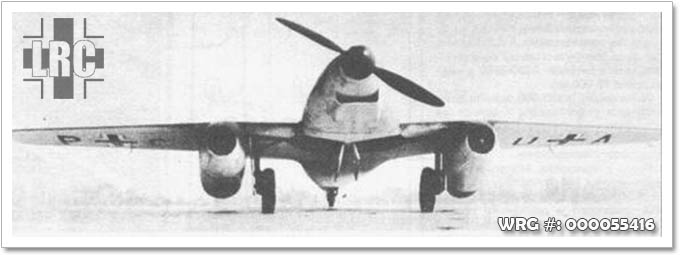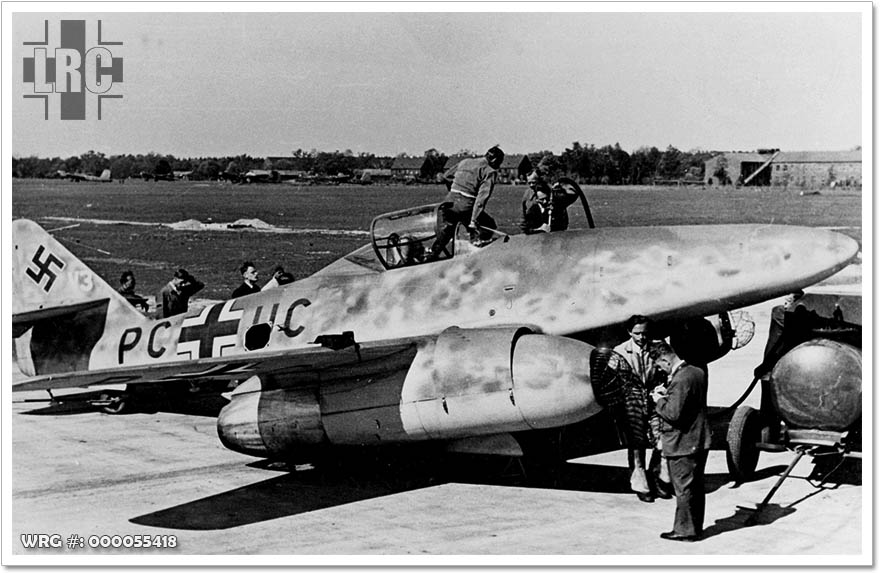Messerschmitt Me 262
Design & Development
Several years before World War II, the Germans foresaw the great potential for aircraft that used the jet
engine constructed by Hans Joachim Pabst von Ohain in 1936. After the successful test flights of the
world's first jet aircraft—the Heinkel He 178—within a week of the Invasion of Poland to start the war,
they adopted the jet engine for an advanced fighter aircraft. As a result, the Me 262 was already under
development as Projekt 1065 (P.1065) before the start of World War II. The project originated with a
request by the Reichsluftfahrtministerium (RLM, Ministry of Aviation) for a jet aircraft capable of one
hour's endurance and a speed of at least 850 km/h (530 mph; 460 kn). Dr Waldemar Voigt headed the
design team, with Messerschmitt's chief of development, Robert Lusser, overseeing.
Plans were first drawn up in April 1939, and the original design was very different from the aircraft that
eventually entered service, with wing root-mounted engines, rather than podded ones, when submitted in
June 1939. The progression of the original design was delayed greatly by technical issues involving the
new jet engine. Because the engines were slow to arrive, Messerschmitt moved the engines from the wing
roots to underwing pods, allowing them to be changed more readily if needed; this would turn out to be
important, both for availability and maintenance. Since the BMW 003 jets proved heavier than
anticipated, the wing was swept slightly, by 18.5°, to accommodate a change in the center of gravity.
Funding for the jet engine program was also initially lacking as many high-ranking officials thought the
war could easily be won with conventional aircraft. Among those were Hermann Göring, head of the
Luftwaffe, who cut the engine development program to just 35 engineers in February 1940 (the month
before the first wooden mock-up was completed); Willy Messerschmitt, who desired to maintain mass
production of the piston-powered, 1935-origin Bf 109 and the projected Me 209; and Major General
Adolf Galland, who had initially supported Messerschmitt through the early development years, flying
the Me 262 himself on 22 April 1943. By that time, problems with engine development had slowed
production of the aircraft considerably. One particularly acute problem arose with the lack of an
alloy with a melting point high enough to endure the high temperatures involved, a problem that by
the end of the war had not been adequately resolved. The aircraft made its first successful
flight entirely on jet power on 18 July 1942, powered by a pair of Jumo 004 engines, after a
November 1941 flight (with BMW 003s) ended in a double flameout.
The project aerodynamicist on the design of the Me 262 was Ludwig Bölkow. He initially designed the wing
using NACA airfoils modified with an elliptical nose section. Later in the design process, these were
changed to AVL derivatives of NACA airfoils, the NACA 00011-0.825-35 being used at the root and the
NACA 00009-1.1-40 at the tip. The elliptical nose derivatives of the NACA airfoils were used on the
horizontal and vertical tail surfaces. Wings were of single-spar cantilever construction, with stressed
skins, varying from 3 mm (0.12 in) skin thickness at the root to 1 mm (0.039 in) at the tip. To expedite
construction, save weight and use less strategic materials, late in the war, wing interiors were not
painted. The wings were fastened to the fuselage at four points, using a pair of 20 mm (0.79 in) and
forty-two 8 mm (0.31 in) bolts.
In mid-1943, Adolf Hitler envisioned the Me 262 as a ground-attack/bomber aircraft rather than a defensive
interceptor. The configuration of a high-speed, light-payload Schnellbomber ("fast bomber") was intended to
penetrate enemy airspace during the expected Allied invasion of France. His edict resulted in the
development of (and concentration on) the Sturmvogel variant. It is debatable to what extent Hitler's
interference extended the delay in bringing the Schwalbe into operation; it appears engine vibration
issues were at least as costly, if not more so. Albert Speer, then Minister of Armaments and War
Production, in his memoirs claimed Hitler originally had blocked mass production of the Me 262, before
agreeing in early 1944. Hitler rejected arguments the aircraft would be more effective as a fighter
against the Allied bombers destroying large parts of Germany, and wanted it as a bomber for revenge
attacks. According to Speer, Hitler felt its superior speed compared to other fighters of the era meant
it could not be attacked, and so preferred it for high altitude straight flying.
The Me 262 is often referred to as a "swept wing" design as the production aircraft had a small, but
significant leading edge sweep of 18.5° which likely provided an advantage by increasing the critical Mach
number. Sweep, uncommon at the time, was added after the initial design of the aircraft. The engines
proved heavier than originally expected, and the sweep was added primarily to position the center of lift
properly relative to the center of mass. (The original 35° sweep, proposed by Adolf Busemann, was not
adopted.) On 1 March 1940, instead of moving the wing backward on its mount, the outer wing was
re-positioned slightly aft; the trailing edge of the midsection of the wing remained unswept. Based on data
from the AVA Göttingen and wind tunnel results, the inboard section's leading edge (between the nacelle
and wing root) was later swept to the same angle as the outer panels, from the "V6" sixth prototype onward
throughout volume production.
Test flights
Test flights began on 18 April 1941, with the Me 262 V1 example, bearing its Stammkennzeichen radio code letters of PC+UA, but since its intended BMW 003 turbojets were not ready for fitting, a conventional Junkers Jumo 210 engine was mounted in the V1 prototype's nose, driving a propeller, to test the Me 262 V1 airframe.

Messerschmitt Me 262 V1
When the BMW 003 engines were installed, the Jumo was retained for safety, which proved wise as both 003s
failed during the first flight and the pilot had to land using the nose-mounted engine alone. The V1 through
V4 prototype airframes all possessed what would become an uncharacteristic feature for most later jet
aircraft designs, a fully retracting conventional gear setup with a retracting tailwheel—indeed, the very
first prospective German "jet fighter" airframe design ever flown, the Heinkel He 280, used a retractable
tricycle landing gear from its beginnings, and flying on jet power alone as early as the end of March 1941.
The V3 third prototype airframe, with the code PC+UC, became a true jet when it flew on 18 July 1942 in Leipheim
near Günzburg, Germany, piloted by test pilot Fritz Wendel. This was almost nine months ahead of the British
Gloster Meteor's first flight on 5 March 1943. Its retracting conventional tail wheel gear (similar to other
contemporary piston powered propeller aircraft), a feature shared with the first four Me 262 V-series
airframes, caused its jet exhaust to deflect off the runway, with the wing's turbulence negating the effects
of the elevators, and the first takeoff attempt was cut short.

Messerschmitt Me 262 V3
On the second attempt, Wendel solved the problem by tapping the aircraft's brakes at takeoff speed, lifting the
horizontal tail out of the wing's turbulence. The aforementioned initial four prototypes (V1-V4) were built
with the conventional gear configuration. Changing to a tricycle arrangement—a permanently fixed undercarriage
on the fifth prototype (V5, code PC+UE), with the definitive fully retractable nosewheel gear on the V6 (with
Stammkennzeichen code VI+AA, from a new code block) and subsequent aircraft corrected this problem.
Test flights continued over the next year, but engine problems continued to plague the project, the Jumo 004
being only marginally more reliable than the lower-thrust (7.83 kN/1,760 lbf) BMW 003. Airframe modifications
were complete by 1942 but, hampered by the lack of engines, serial production did not begin until 1944, and
deliveries were low, with 28 Me 262s in June, 59 in July, but only 20 in August.
By Summer 1943, the Jumo 004A engine had passed several 100-hour tests, with a time between overhauls of 50
hours being achieved. However, the Jumo 004A engine proved unsuitable for full-scale production because of
its considerable weight and its high utilization of strategic material (Ni, Co, Mo), which were in short
supply. Consequently, the 004B engine was designed to use a minimum amount of strategic materials. All high
heat-resistant metal parts, including the combustion chamber, were changed to mild steel (SAE 1010) and
were protected only against oxidation by aluminum coating. The total engine represented a design
compromise to minimize the use of strategic materials and to simplify manufacture. With the
lower-quality steels used in the 004B, the engine required overhaul after just 25 hours for a
metallurgical test on the turbine. If it passed the test, the engine was refitted for a further
10 hours of usage, but 35 hours marked the absolute limit for the turbine wheel. While BMW's and
Junkers' axial compressor turbojet engines were characterised by a sophisticated design that could
offer considerable advantage – also used in a generalized form for the contemporary American
Westinghouse J30 turbojet – the lack of rare materials for the Jumo 004 design put it at a
disadvantage compared to the "partly axial-flow" Power Jets W.2/700 turbojet engine which, despite
its own largely centrifugal compressor-influenced design, provided (between an operating overhaul
interval of 60–65 hours) an operational life span of 125 hours. Frank Whittle concludes in his
final assessment over the two engines: "it was in the quality of high temperature materials that
the difference between German and British engines was most marked"
Operationally, carrying 2,000 litres (440 imperial gallons; 530 US gallons) of fuel in two 900-litre
(200-imperial-gallon; 240-US-gallon) tanks, one each fore and aft of the cockpit; and a 200-litre
(44-imperial-gallon; 53-US-gallon) ventral fuselage tank beneath, the Me 262 would have a total
flight endurance of 60 to 90 minutes. Fuel was usually J2 (derived from brown coal), with the option of
diesel or a mixture of oil and high octane B4 aviation petrol. Fuel consumption was double the rate of
typical twin-engine fighter aircraft of the era, which led to the installation of a low-fuel warning
indicator in the cockpit that notified pilots when remaining fuel fell below 250 l (55 imp gal;
66 US gal).
Unit cost for an Me 262 airframe, less engines, armament, and electronics, was RM87,400. To build one
airframe took around 6,400 man-hours.
Test flights began on 18 April 1941, with the Me 262 V1 example, bearing its Stammkennzeichen radio code letters of PC+UA, but since its intended BMW 003 turbojets were not ready for fitting, a conventional Junkers Jumo 210 engine was mounted in the V1 prototype's nose, driving a propeller, to test the Me 262 V1 airframe.

Messerschmitt Me 262 V1

Messerschmitt Me 262 V3
Sources:
Gunston, Bill & Wood, Tony - Hitler's Luftwaffe , 1977, Salamander
Books Ltd., London
, 1977, Salamander
Books Ltd., London
Wikipedia - ME 262
Gunston, Bill & Wood, Tony - Hitler's Luftwaffe
Wikipedia - ME 262






